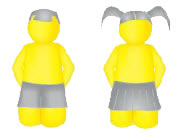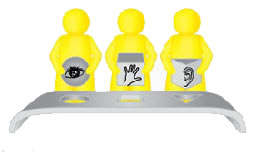
In the Classroom
What does differentiation look like in an effective classroom?

Use of grouping
- range of criteria: ability, social, readiness, interest, learning profiles, gender, culture.
- flexibility: movement across groups, alternative seating
- range of group size: pairs, small group, full class, cross-grouping within team or across levels.

Flexible expectations
- amount of teacher support
- home situation impacting on homework
- time needed to complete tasks (processing/physical)
- first language
- behaviour management strategies
- culture
- provision of group targets/extension work

Provision & modification of a range of teaching strategies
- formative assessment used to modify planning
- direct instruction
- open and closed questions on different levels
- provision of scaffolding to move students on
- buddy support
- teacher and student modelling
- Gardner’s multiple intelligences & Bloom’s taxonomy
- Wonder Wall and Blue Sky Time
- regular feed back & feed forward

Provision of range of tasks & opportunities within tasks
- tasks set/modified according to levels & abilities
- co-operative tasks
- visual, auditory & kinaesthetic tasks
- choice of content, process & product.
- learning centres
Variation of Timing
- range of timings depending on the task
- extra time for slower processors
- extra time for in depth exploration of concepts
- opportunities for more able/faster processors to move on after sampling of tasks
Provision and use of range of resources
- individual, small group and class
- visual, auditory and kinaesthetic
- relevant, modern and stimulating
- opportunities for student choice
- accessible
|
Ability |
Interest |
Learning Styles |
|
Provision & modification of a range of teaching strategies eg use of assessment to inform planning, provision of scaffolding, teacher/student modelling, direct instruction, buddy support Use of a range of groupings eg size, ability, mixed ability Flexible expectations eg amount of teacher support, time given, reinforcement/extension work Provision of a range of tasks/opportunities within tasks eg modify/set range of activities |
Provision & modification of a range of teaching strategies eg using student worlds as springboard for learning, open & closed questions, Wonder Wall, Sky Blue time, extra curricular activities Use of a range of groupings eg gender, culture, social, alternative seating, cross grouping Provision of a range of tasks and opportunities within tasks eg building on student’s passions, co-operative tasks, choice, learning centres Provision and use of a range of resources eg individual, group & class, relevant, modern & stimulating, choice
|
Provision & modification of a range of teaching strategies eg provision of scaffolding, teacher/student modelling, Gardner’s multiple intelligences & Blooms Taxonomy Use of a range of groupings eg size, culture, gender, cross groupings Flexible expectations eg time given to complete tasks, culture, first language Provision of a range of tasks, and opportunities within tasks eg visual, auditory & kinaesthetic tasks, student choice Provision and use of a range of resources eg visual, auditory & kinaesthetic, student choice
|
|
Content |
Process |
Product |
|
Provision of a range of tasks/ opportunities within tasks eg wonder wall, blue sky time, ignition, highlighting text, skip content, choice Use of a range of groupings eg ability,readiness, interest, gender, culture Flexible expectations eg first language, reinforcement & extension activities, behaviour management strategies Provision & modification of a range of teaching strategies eg direct instruction, open & closed questions on different levels, teacher/student modelling, Wonder Wall and Sky Blue Time Provision of a range of tasks & opportunities within tasks eg tasks set/modified according to choice of content, learning centres Provision & use of range of resources eg relevant, modern & stimulating |
Provision & modification of a range of teaching strategies eg use of formative assessment to modify planning, regular feed back and feed forward, Gardner’s multiple intellegencies, open and closed questions on different levels, teacher & student modelling Use of a range of groupings according to readiness, interests & learning styles Provision and use of a range of resources eg kinaesthetic, visual & auditory, learning centres
|
Provision of a range of tasks & opportunities within tasks for choice eg: chart, oral report, flow diagram, poster, diorama Flexible expectations eg the quality of product depending on the child's readiness, interest and learning, varied homework Use of a range of groupings eg ability, social, readiness, interest, learning styles, gender, culture Provision & modification of a range of teaching strategies eg regular feed back and feed forward Variation of Timing eg range of timings depending on the task, opportunities for more able/faster processors to move on Provision of a range of resources eg individual, small group & class, opportunities fro student choice, accessible
|

